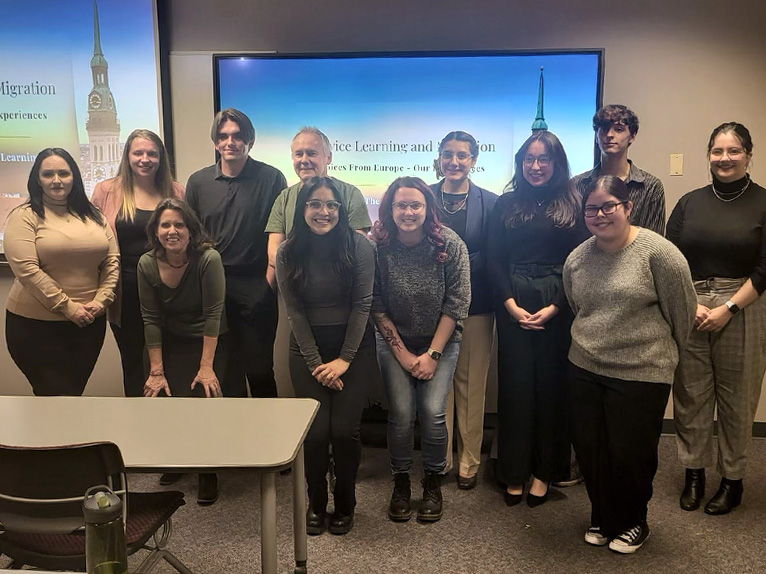Government students reflect on service learning trip to Germany
More stories from Claire Quintana
Government students presented their takeaways from a service learning project to Munich, Germany on Nov. 15, 2022, in Breland Hall.
Government Professor Sabine Hirschauer and 11 of her students discussed their experiences on the 2022 Migration and Integration Service Study-Abroad trip in Munich, Germany on Nov. 15, 2022, in Breland Hall. The students were in Germany from June 26 to July 9 where they toured a concentration camp and learned about immigration processes in Germany.
Hirschauer said that the goal of the “service-learning program” was to give students the opportunity to learn more about the “challenges and complexity of migration and integration in Germany.”
She explained that migration is so different in Germany because they are still figuring out how to deal with their past and how to overcome feelings of racism.
“Migration is very complicated. We fear people who look differently than we do; who speak a different language and who come from a completely different social and political background. But we all want the same things,” Hirschauer said in a statement.
She noted that was the main thing she wanted her students to learn and hopes to help facilitate discussion between Germans and Americans in the borderland.
“We are trying to bring some of the German professors and German nongovernmental organization workers from Munich to NMSU. Refugee NGOs here in the borderland would then meet and exchange their advocacy experiences with their German counterparts,” Hirschauer said.
Danielle Dowis discussed her experience in Munich Central, where they learned about the different sides of immigration. She specifically talked about the Ukrainian refugees and the processes they go through when seeking asylum.
“The info spot was the first place that Ukrainian refugees came and it was essentially like a welcome center where volunteers spoke Ukrainian, German, and Russian. So people can actually talk and get directions on how to proceed,” Dowis said.
She also mentioned how they then either went to a camp or to a hotel to begin their asylum-seeking processes.
“We also went to the Welcome Center and it was where Ukrainian refugees would go if they needed extra help before they started the intensive process [of integration].”
Jasmine Recinos was part of the group that went to Fürstenfeldbruck, where they learned about the refugee camp that was about an hour and a half away from the city.
“I want to emphasize the ostracization and seclusion the migrants feel when they have to go way out of the main central station and go to this different location that’s out of the way,” Recinos said.
Cole Vetter reemphasized the camp’s isolation and how it ostracizes the migrants to the point where they can’t move along their refugee processes. He said that along with this, there was an obvious difference between the way Ukrainians and other races were treated.
“There was this unfair treatment between the Ukrainian refugees and the Afghan and Nigerian refugees. They would stay in the camp for months and months and wouldn’t be able to find a job or housing, while the Ukrainians would find these things in a few weeks,” Vetter said.
Annika Newman was part of the group that went to Freising, where they went to a refugee office and camp. Newman said that while the office refugees had a more established life, the camp refugees were experiencing difficulties.
“A big thing that the [Nigerian refugees] had talked to us about was that the government officials running the camp didn’t care about refugee complaints,” Newman said. “They also talked to us about the rooms in the camp and they were telling us that multiple families would have to share [small] rooms.”
Citlalli Benitez also went to Freising and Moosburg, where she and her group got to sit in on consultations between social workers and refugees.
“It was clear that their emphasis on social integration and participation as an organization was extremely apparent in the work we got to see every day, and it made a world’s difference,” Benitez said.
The students attending the trip also toured parts of Germany and attended multiple workshops as a large group, including things like the Sierra Leone Protest Camp or the Dachau concentration camp.
“We had the opportunity to participate in multiple workshops,” Newman said. “In these workshops, we were able to listen, learn, and interact with history and people from Germany.”
After sharing their Germany experience, the students answered questions from the audience in a panel format, where they came to the general conclusion that there was a common theme of racism towards immigrants throughout the trip.
Dowis said that the Munich Central group spent the most time with the Ukrainians, so they were able to see the first-hand experience of Ukrainian refugees compared to the other refugees.
“The most obvious [sign of better treatment] was that Ukrainian refugees could get a work visa almost immediately. And that was that’s a really big problem and a really big concern with other asylum seekers in Germany,” Dowis said.
Hirschauer said that, despite all the hardship migrants in Germany have, it is still considered the best place in the world for immigration.
“I think the point is, it’s relative and compared to everybody else, every other country, Germany is still the best country. And so everybody else is pretty bad,” Hirschauer said.

Claire Zuloaga is entering her third year with The Round Up as the Managing Editor. She is in her senior year, studying Journalism & Media Studies...

